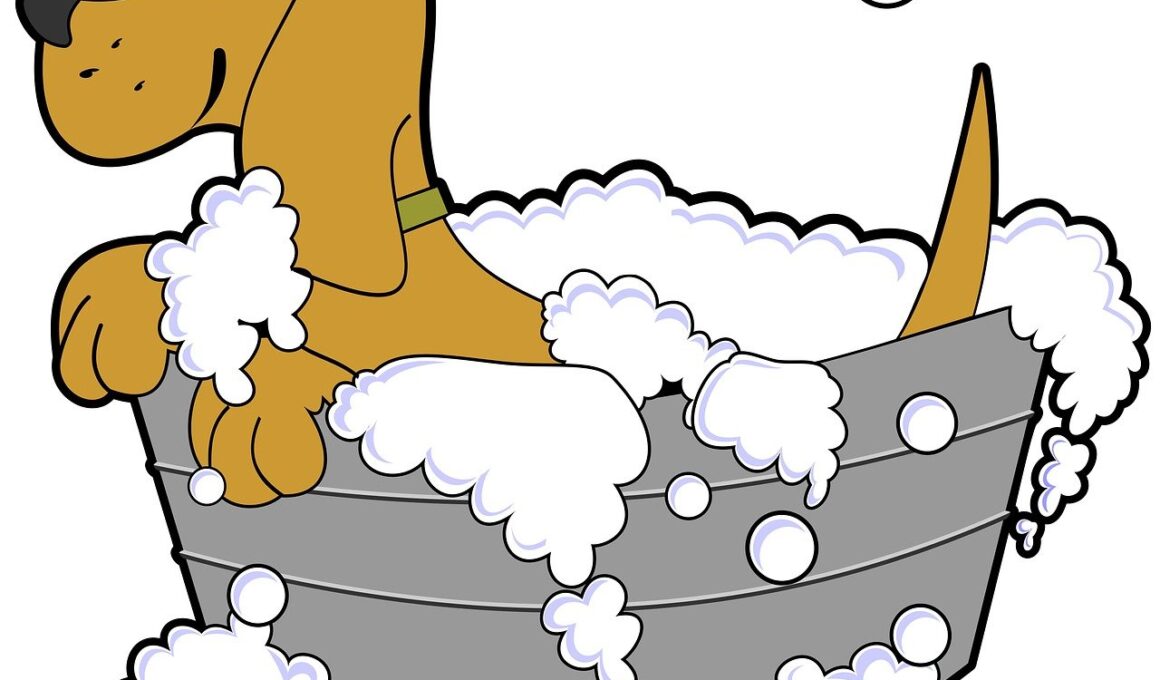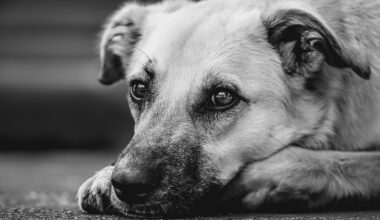Bathing Tips Tailored to Various Dog Breed Coats
Bathing your dog is a crucial part of grooming that goes beyond mere aesthetic appearances. Each breed has its unique coat type, requiring specific care techniques for optimal cleanliness and health. Understanding the characteristics of different dog breeds helps in providing a tailored bathing experience. For example, breeds with long fur, such as Afghan Hounds, benefit from regular baths to avoid matting and tangles. Their silky coat requires careful handling to prevent any form of damage. Conversely, breeds like Bulldogs with short, smooth coats generally need fewer baths. Their skin tends to be more oily, and frequent washing can lead to dryness or irritation. For terriers, seasonal bathing based on their work and outdoor exposure is essential, as their coats collect dirt and debris. When choosing a shampoo, always opt for one specifically formulated for dogs, as regular human shampoos can disrupt their skin’s natural pH. Additionally, using water correctly is important; lukewarm water is preferred to ensure comfort during the bathing process. Drying techniques also vary based on coat type, so take the time to learn what’s best for your pet’s specific needs.
For dogs with a dense double coat, such as Siberian Huskies, bathing practices should take into consideration their unique hair structure. This breed has a thick undercoat that sheds heavily, especially during seasonal changes. To manage the shedding effectively, a bath with the right shampoo can help remove loose fur to keep your house clean. While it’s tempting to wash a Husky frequently due to their heavy shedding, you should be careful; too many baths can strip their coat of natural oils, leading to dry skin. It is suggested to bathe them every couple of months, unless they get particularly dirty or smelly. For grooming purposes, use a good conditioner specifically designed for double-coated breeds. It helps to detangle without damaging their fur. Additionally, brushing their coat before and after the bath will remove loose hairs and help in the drying process. Huskies often love water; thus, making bath time enjoyable is essential. A positive experience will ensure easier grooming sessions in the future. Always remember, ample rinsing is crucial to avoid residue buildup. This ensures their coat remains healthy and looking its best.
Poodles and Their Unique Bathing Needs
When it comes to Poodles, their curly coats require distinct bathing approaches. Regular baths are necessary, as their tight curls tend to trap dirt and moisture leading to skin issues if not maintained properly. Bathing should ideally occur every three to four weeks, using high-quality dog shampoos and conditioners to enhance coat texture and prevent matting. Drying should be done with care, as excess moisture can cause skin problems. Air drying or gentle towel drying is recommended after a wash. It is also essential to brush their coat before and after each bath, ensuring any tangles are addressed. Keeping their coat trimmed helps minimize matting, but when they do get dirty, consider using specific coat oils for added moisture during the drying process. Checking their ears and eyes post-bath is crucial, as water can accumulate, leading to infections. For Poodle owners, regular grooming appointments can also help maintain their coat’s health. Ultimately, Poodles thrive on routine and consistent care. Establishing a bathing schedule early on aids in fostering a strong bond with your furry friend.
Grooming methods for Dachshunds differ significantly due to their unique coat textures. They come in three types: smooth, long-haired, and wire-haired, each requiring different bathing techniques. For smooth-coated Dachshunds, baths are relatively infrequent; twice a year is sufficient unless they roll in something smelly. Their skin responds well to mild dog shampoos. For long-haired varieties, more attention is needed; regular baths keep their fur clean and help reduce matting. Brushing them before and after helps preserve their sleek appearance and reduces tangles. Wire-haired Dachshunds need specific care, with occasional hand-stripping to maintain coat quality. Bathing should be carried out carefully, ensuring no product residue remains. Each variety benefits from conditioner designed for their coat type. After bathing, a short blow-dry on low can help if the weather permits, avoiding dampness that can lead to skin issues. It’s important to focus on their ears, as moisture can accumulate there. Regular grooming sessions, combined with proper bathing, promote not only a clean dog but a happier one too. Learning these small nuances will greatly improve your grooming routine.
Understanding the Bathing Routine for Bichon Frises
The Bichon Frise, recognized for its fluffy white coat, demands a consistent bathing and grooming routine to maintain its signature look. These dogs require baths every four to six weeks, utilizing a gentle, hypoallergenic shampoo that maintains their skin and coat health. Their coat is prone to matting, so brushing before and after bath time is crucial. Specifically designed grooming tools, like a slicker brush, can help remove tangles effectively. Giving attention to their feet and face is essential too, as these areas can trap dirt. When washing a Bichon Frise, use warm water and be careful of their eyes and ears—keeping them dry is paramount. A thorough rinse is necessary to produce a shampoo-free coat that looks crisp and well-groomed. After bathing, use a dog conditioner; it ensures a soft texture that’s pleasant to touch. Some owners prefer to dry their Bichon using a professional pet dryer, but ensure it is set to a low temperature. Keeping up with their regular grooming appointments helps maintain a clean and elegant appearance overall. Positive experiences during bath time can foster trust and enjoyment.
Your Golden Retriever is another example of a breed that benefits from a specific bathing routine. Given their water-loving nature and lovely thick fur, Golden Retrievers will thrive with frequent baths during warm months but can go longer between baths in cooler months. Ideally, bathing should occur every six to eight weeks. The right approach involves using moisturizing dog shampoos, suitable for their skin type, especially if your dog has developed any allergies or sensitivities. They love water, making bath time usually enjoyable, which can simplify the cleaning process. Rinsing thoroughly is essential to remove any shampoo residue that could irritate their skin. Also, regular brushing alleviates shedding, especially during seasonal coat changes. Post-bathing, a good quality conditioner helps maintain their coat’s luxurious feel. Drying can be quick with a towel or a gentle dog dryer, focusing on areas that trap moisture, like under the chest and belly. Keeping up with your Golden’s grooming ensures their coat remains healthy and shining bright. Birds and parasites can be combated effectively through regular bathing routines combined with professional grooming support.
Bathing Considerations for Short-Haired Breeds
Short-haired breeds tend to require a different bathing strategy than their long-haired counterparts. Breeds like Beagles and Boxers are among those that typically need less frequent baths. In general, these dogs can go longer periods between baths, about every two to three months. However, they still need essential care to keep their coat shiny and healthy. A gentle, pH-balanced dog shampoo is key. During the bath, focus on areas that might trap dirt, such as their paws and underbelly. Furthermore, using a rinse aid designed for dogs can help enhance skin health and give their coat a nice shine. Pay attention to their ears and pads as well, as these areas can accumulate grime. Regular brushing during non-bathing days helps reduce shedding while stimulating the skin, contributing to overall health. After bathing, ensure complete drying, as dampness could lead to itching and other skin concerns. As an owner, understanding the specific needs of your dog’s breed is essential for effective grooming. Ultimately, routine and consistency in bathing habits promote better physical and emotional health.
Understanding your dog’s unique grooming needs is essential for every pet owner. Bathing is just one piece of a holistic approach to grooming and health. Each breed exhibits distinct traits that dictate how often and in what manner they should be groomed. Bathing not only cleanses but also strengthens your bond through interaction and care. Regularly assessing your dog’s coat condition and adjusting bathing routines as needed is advisable. Using the appropriate grooming tools helps in managing their coat type, which reduces the risk of matting or skin problems. Being informed about allergens and choices of shampoos can enhance a dog’s comfort during the process. Consider involving your pet in grooming routines from an early age; this builds trust and reduces anxiety during baths. Consulting with a professional groomer can offer tailored advice that matches both your lifestyle and your dog’s individual needs. When your furry friend enjoys bath time, you create a positive experience, making future grooming easier and more enjoyable. Overall, learning about your dog’s needs will result in better care and happier pets.


